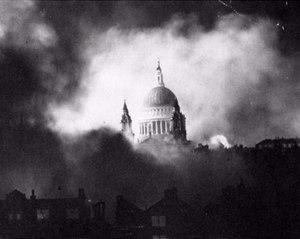Pimlico was as badly damaged as other parts of London more commonly associated with the Blitz (the East End and the Docks), as evidenced by the film Passport to Pimlico . The mass destruction, privation and a city’s defiance from 1940-1945 summons up many images, Herbert Mason’s famous 1940 photograph of St Paul’s Cathedral surrounded by flames (left) and grainy newsreels are instantly recognisable and inspiring.
Seventy years on, a new exhibition of rarely-seen oil and watercolour pieces by Westminster’s war artists reveals the Blitz by brushstroke. Much like journalists, WAAC artists tried to arrive at the scene of bomb incidents as soon as possible to capture the authentic, often chaotic, aftermath.
Marking the 70th anniversary of the Blitz, West End at War, a new Heritage-Lottery funded exhibition from the City of Westminster Archives, offers a rare chance to see the work of London’s official war artists at The SW1 Gallery in Victoria , the exhibition ends on 13 January 2011.
The War Artists Advisory Committee (WAAC) – wartime arts subsidiary of the Ministry of Information – was founded in November 1939. Art was not a luxury; it was a vital necessity, to be used to boost the morale of the nation’s civilians and soldiers, and abstract artists were excluded in favour of artworks covering traditional themes of heroism, national vigour and resistance.
Art road shows travelled from London to over 100 sites across Britain, including to the factories and military bases responsible for the nation’s defence, although the WAAC founder later admitted his real reason for setting up WAAC “was simply to keep artists at work on any pretext, and as far as possible, stop them from getting killed.”!
An inner core of (salaried) artists were commissioned, Graham Sutherland, John Piper, Henry Moore, Stanley and Gilbert Spencer, Barnett Freedman, RG Mathews, and over 40 leading women artists including Dame Laura Knight. A total of 400 WAAC official war artists were selected and encouraged to pursue their own subjects and pitch ideas. Many were allocated roles within specific ministries or attached individually to the Royal Navy, Army or Royal Air Force (RAF). By war’s end in 1945 they had produced over 6,000 artworks.





